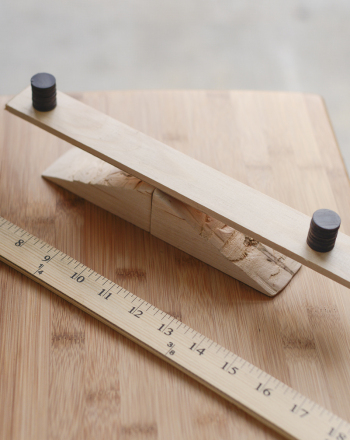Science project
Centripetal and Centrifugal Force
Have you ever wondered why you don’t fall out of an upside down loop on a roller coaster, or why a satellite can stay in orbit around the earth? Centripetal force is a force that causes an object to move along a curved path by pulling the object towards the center of the path. The velocity (speed and direction) of the object is constantly changing because the direction of the object is constantly changing, even though the speed remains the same unless acted upon by an outside force. The direction of such an object at any given point is always perpendicular to the centripetal force.
For a circle, the centripetal force is given by the following equation:
F = mac = (mv2 / r)
Where F is the force in Newtons, m is the mass of an object in kilograms, and ac is the centripetal acceleration which can also be described by v2/r, the square of the velocity divided by the radius (the distance from the center of the circle).
For objects traveling in a vertical orientation, meaning at some point they are upside down, the centripetal force must be at least equal to the gravitational force, so the object (or person!) does not fall.
Objective:
Observe centripetal force in action, and use the centripetal force equation to predict the results of the experiment.
Hypothesis:
What will happen to the water in the bucket when the bucket is spun faster? Slower?
Materials:
- Plastic bucket with handle
- Scale
- Large jug
- Water
- Meter stick
- Notebook and pencil
Procedure:
- Measure your arm from the shoulder to your hand. When spinning the bucket, this will be the radius of the circle. Record the length in meters.
- Weigh the bucket on the scale. Record the weight.
- Place the large jug on the scale and record the weight.
- Pour water into the jug and record the weight. Subtract the weight of the jug to get the weight of the water alone.
- Convert the weight of the water into kilograms. Why is it important that the mass is in kilograms?
- Pour the water into the bucket.
- Go outside to an area where it is okay to spill water. With your arm fully extended, swing the bucket around in circles.
- Swing the bucket slower and slower until the water spills out.
- Using the centripetal force equation, calculate the velocity of your spin for the mass of water in the bucket. How do you solve for velocity? What is significant about this force? This velocity?
- Repeat the experiment with different masses of water, or even different radii by tying a rope to the bucket handle.
- Compare centripetal force to gravity exerted on the water. How much water can you swing for a given velocity?
Results:
The water will spill out of the bucket when the gravitational force of the water exceeds the centripetal force exerted on the water when it is upside down.
Why?
Centripetal force exerted on a spinning object like our bucket of water also leads to an equal and opposite centrifugal force, the force that the rotating object exerts on the restraining mass (the hand that is swinging the bucket). These two forces work in opposition, which pushes the water to the bottom of the bucket as it passes overhead. Centrifugal force is a consequence of inertia—the tendency of a moving object to want to continue moving in a straight line. As we fling our bucket of water in an arc over our head, the water wants to continue traveling in a straight line, but the force of our hand constantly redirects the water so it travels in an arc instead! Water’s inertia resists this redirection, causing the force of the water to push against the bottom of the bucket. It’s a great example of Newton’s third law: Our hand pulls on the bucket to change the direction of the water from a straight line to an arc (centripetal force), and the centrifugal force from the water pushes the water to the bottom of the bucket!
Here’s an analogous situation: Imagine you’re riding as a passenger in your dad’s car. He makes a really sharp turn, and as a result, you feel like you’re being thrown against the inside of the car door. What’s really happening is that your body wants to continue moving forward, but the turning car pulls your body in a new direction. Your body’s intertia resists this pull, because like all objects, it wants to continue traveling in a straight line.
Now, let’s take a look at the math.
To solve for velocity of your swinging bucket, you have to calculate the gravitational force that acts on the water:
Fg=mg
Where Fg is the gravitation force in Newtons, m is the mass of the water and g is the acceleration due to gravity, which is 9.81m/s on Earth.
The water will spill from the bucket when the gravitational force is slightly greater than the centripetal (or centrifugal) force, so for simplicity they can be set to equal each other, the variables rearranged, and solved. It is important that weight (mass) is measured in kilograms because that the units in the equation must be consistent for the equation to be true.
Education.com provides the Science Fair Project Ideas for informational purposes only. Education.com does not make any guarantee or representation regarding the Science Fair Project Ideas and is not responsible or liable for any loss or damage, directly or indirectly, caused by your use of such information. By accessing the Science Fair Project Ideas, you waive and renounce any claims against Education.com that arise thereof. In addition, your access to Education.com's website and Science Fair Project Ideas is covered by Education.com's Privacy Policy and site Terms of Use, which include limitations on Education.com's liability.
Warning is hereby given that not all Project Ideas are appropriate for all individuals or in all circumstances. Implementation of any Science Project Idea should be undertaken only in appropriate settings and with appropriate parental or other supervision. Reading and following the safety precautions of all materials used in a project is the sole responsibility of each individual. For further information, consult your state's handbook of Science Safety.











